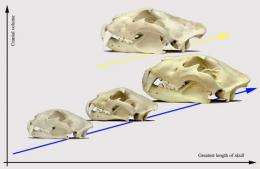Are tigers 'brainier' than lions?

(PhysOrg.com) -- A wide-ranging study of big cat skulls, led by Oxford University scientists, has shown that tigers have bigger brains, relative to their body size, than lions, leopards or jaguars.
The team investigated the relationship between the skull size - the longest length between the front and back parts of the skull - of a large sample of tigers, lions, leopards and jaguars and the volume inside the cats’ respective craniums. The researchers report their findings in this month’s Biological Journal of the Linnean Society.
'What we had not expected is that the tiger has clearly much bigger relative brain size than do the other three species, which all have similar relative brain sizes,’ said Dr Nobby Yamaguchi of Oxford University’s Wildlife Conservation Research Unit (WildCRU), an author of the report with WildCRU Director Professor David Macdonald.
‘When we compare the two biggest species, on average the lion has a bigger skull than the tiger based on the greatest length of the skull. However, the tiger has bigger cranial volume than the lion. It is truly amazing that tiny female Balinese tiger skulls have cranial volumes as large as those of huge male southern African lion skulls.’
It has sometimes been assumed that social species, such as lions, should have larger brains than solitary species, such as tigers, because of the need to handle a more complex social life within groups or prides. However, despite a few studies suggesting a relationship between big brains and sociality in mammals, evidence for the link is far from clear.
Dr Nobby Yamaguchi said: ‘Our results strongly suggest that there is no detectable positive relationship between relative brain size and sociality amongst these four big cat species, which shared a common ancestor around 3.7 million years ago.’
The team also looked at the popular idea that tigers are ‘bigger’ than lions (which could mean that the tiger’s relatively bigger brain size simply reflects its bigger body). However, careful re-evaluation of original field data and relatively well-documented hunting records does not support this idea.
So the team concluded that the tigers have a relatively bigger brain (around 16 per cent larger) than lions, given their very similar average body sizes.
Professor Macdonald said: ‘Two general lessons emerge from our findings: first, how much remains to be discovered about even these most familiar of big cats, and second how important museum collections can be as a source of unexpected insights.’
The next step for the researchers is to try to answer whether such a difference can be explained by intrageneric variation or merely by chance. If not by chance, then it raises the question why the tiger evolved a relatively bigger brain (or why other species evolved smaller brains) after the tiger’s ancestor split from the common ancestor to the other three species.
The answers to both these questions may lie in analysing comparative brain anatomy amongst these species (for instance, which parts of the tiger’s brain are bigger than the lion’s) and similar data from extinct relatives of these big cats as well as smaller living relatives such as the snow leopard and clouded leopard.
Provided by Oxford University (news : web)
















